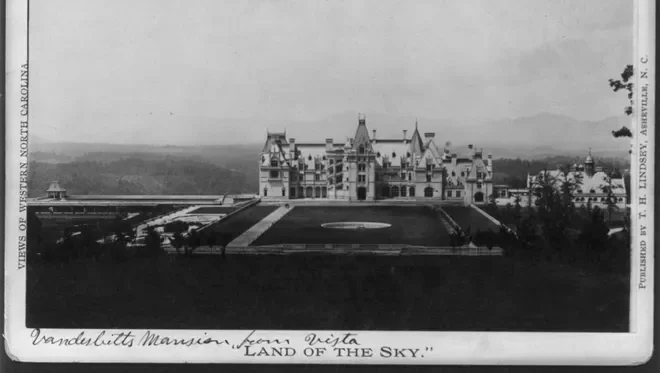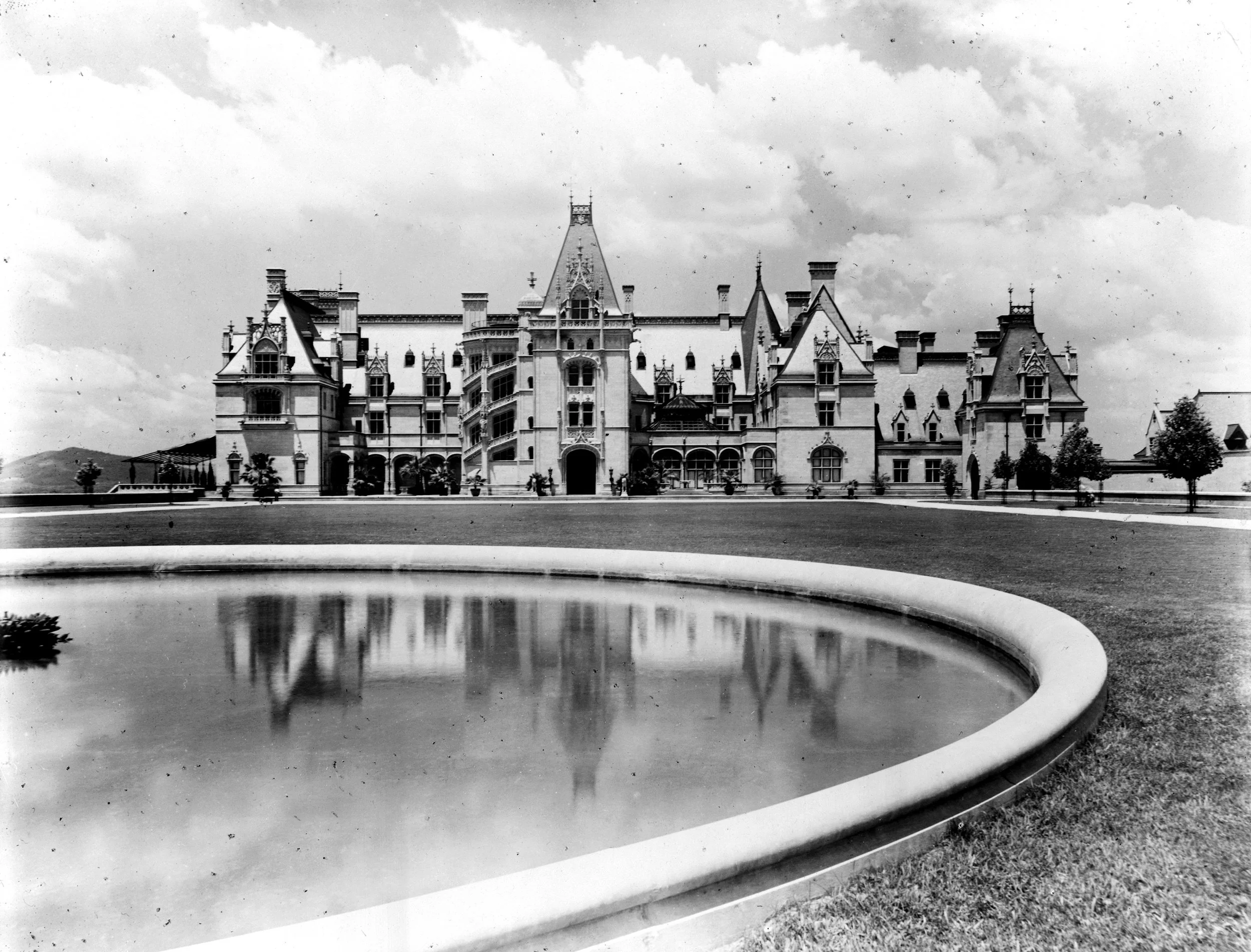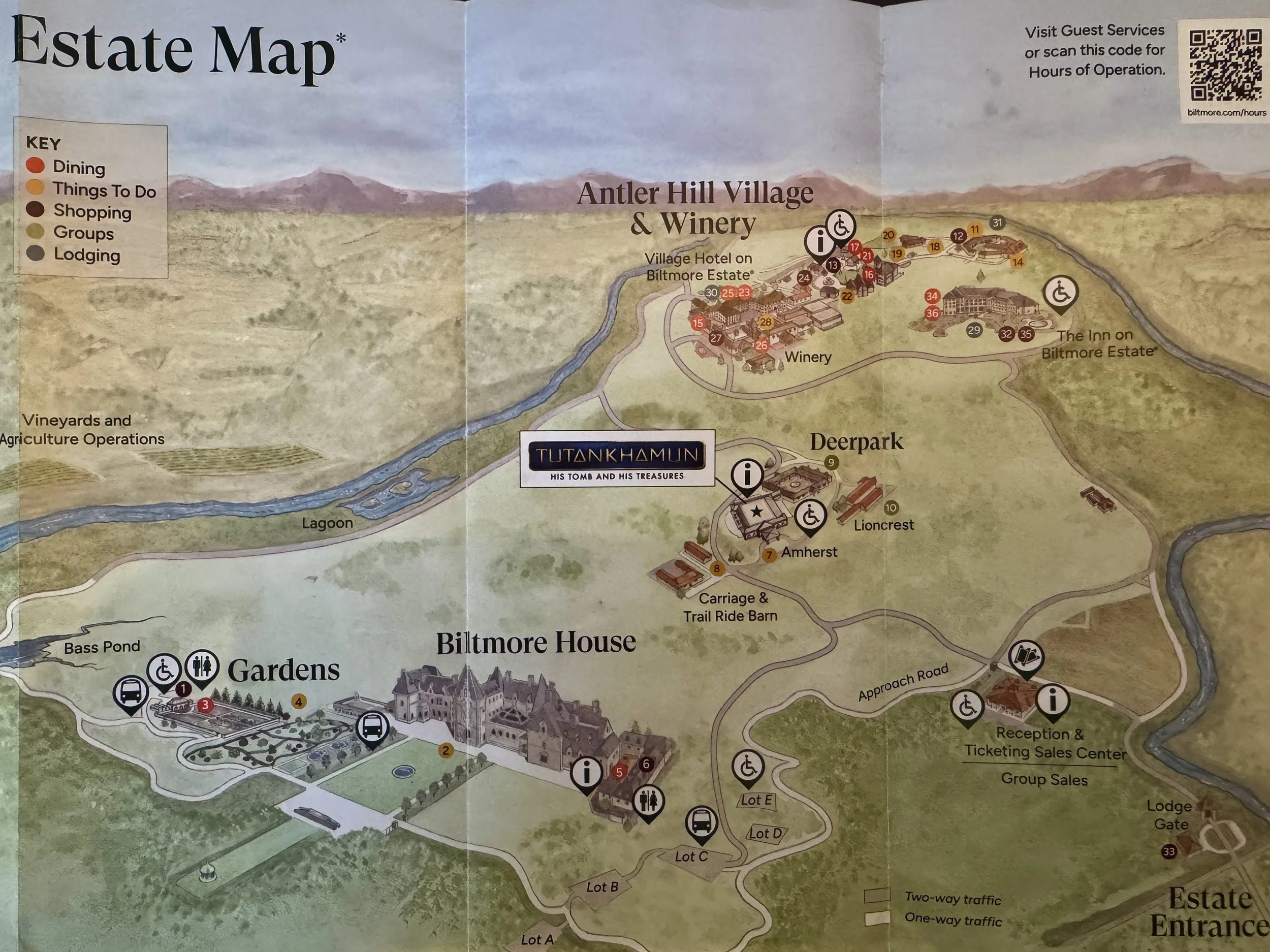Timeless Elegance
A Guide to Exploring Biltmore Estate’s Enduring Beauty
Tucked away in the heart of the Blue Ridge Mountains, Biltmore Estate is not only America’s largest privately owned home but perhaps, the most awe-inspiring. This breathtaking French Renaissance chateau boasts over 250 rooms filled with the elegance and granduer of the Gilded Age. Its stunning architecture, sweeping panoramic views of mountain vistas, and carefully manicured gardens designed by Federick Law Olmsted are legendary.
Whether you're wandering the lavish interior of the mansion, strolling the vibrant grounds and gardens, dining at one of the estate’s acclaimed restaurants, or sipping wine at the award-winning winery, the Biltmore offers a one-of-a-kind experience full of splendor. For those craving a bit of adventure, the estate even offers a surprisingly wide range of outdoor activities including hiking, biking, guided bird watching, falcony, horse riding, and carriage rides - which I admit really surprised me.
Biltmore is so much more than just a historic home. It’s a timeless living legacy of innovation, elegance, and craftsmanship that continues to captivate visitors from around the globe.
TABLE OF CONTENTS:
Staying at Biltmore - The Inn on Biltmore Estate, Village Hotel on Biltmore Estate, Cottages on Biltmore Estate (the Spa for overnight guests/annual pass holders)
Biltmore House - Guided & Self Tours
Outdoor Activities - Hiking, Biking, Falconry & Archery, Horseback Riding, Carriage Rides
HISTORY OF BILTMORE
Biltmore is a remarkable testament to America’s Gilded Age—an era defined by wealth, ambition, and grandeur. Its story began with a vision by George Washington Vanderbilt II, an heir to one of the nation’s wealthiest families who was captivated and fell in love with the Blue Ridge Mountains during his visits to Asheville, North Carolina.
The Vanderbilts were considered "new money" by East Coast elite standards, especially when compared to old European nobility or America’s early colonial families. Their immense fortune was built by George’s grandfather, Cornelius "Commodore" Vanderbilt. He arose from humble beginnings to mass wealth through shipping and railroads in the mid-1800s. George inherited this enormous wealth but wasn’t born into aristocracy which meant he often wasn’t automatically accepted into the more elite circles of high society.
By the late 1800s when George set his sights on building Biltmore, the Gilded Age was its peak. America’s wealthiest were in an unofficial race to construct the most opulent homes, particularly in wealthy enclaves like Newport, Rhode Island, and New York City, New York.
But George wasn’t as flamboyant or flashy as some of his relatives showing off their wealth by building summer cottages in Newport. George took a more refined approach. He envisioned Biltmore being a cultural and social statement reflecting refinery while still elevating the Vanderbilt within high society.
Construction began in 1889. It took six years to complete and the official “opening” took place on Christmas Eve in 1895, at which time George welcomed family and friends to his magnificent new home. In 1914, when George passed away, his only daughter Cornelia Venderbilt and her husband inherited the property.
Photo: Room with fireproof doors where many of America’s most precious works of art were safely hidden in secret during WWII.
Perhaps one of the most fascinating stories about Biltmore Estate took place during World War II, when it played a significant, yet very secretive role in preserving American heritage. In 1942, after Pearl Harbor, fears of an eminent enemy attack on U. S. mainland soil grew. Officials at the National Gallery of Art in Washington D.C. sought a secure location to safeguard the country’s most pricelss works. They selected the Biltmore Estate because of its remote location and the Vanderbilt connections in the art world. The art, including priceless works by Rembrandt, Raphael, and Van Dyck, were transported by train under armed guard and hidden from the public behind the fireproof walls of the estate. Today, you can peer into one of the main rooms where the art was hidden.
Biltmore Estate officially opened to the public in 1930, during the height of the Great Depression. The decision was both practical and strategic. The Depression had taken a toll on families all across the country, including the wealthy like the Vanderbilts. Maintaining such a vast estate was extremley costly and becoming more and more difficult for the Vanderbilts. Opening Biltmore to the public wasn't just about preserving Biltmore - it was also a thoughful way to help the struggling economy of the Asheville community, bringing much needed income to the area through tourism.
Today, the estate is still family-owned, managed by George Vanderbilt’s descendants. What began as a private home has grown into a thriving business including a renowned winery, luxury accommodations for overnight guests, acclaimed restaurants, a working farm, and more than 8,000 acres of beautifully preserved land!
TIPS FOR VISITING
To make the most of your visit to Biltmore Estate, here are some tips for visiting and things to know before you go.
Biltmore is located at 1 Lodge Street, Asheville, North Carolina, in the heart of the Blue Ridge Mountains.
Biltmore is on Eastern Standard Time.
Tickets include a self-guided mansion tour, access to the gardens and trails, and wine tasting at Biltmore Winery.
Biltmore House is open 365 days a year, but hours vary.
When visiting Biltmore House, arrive 30 mintutes before your scheduled time to allow for parking and security.
Book tickets online in advance to ensure availability. Advanced reservations are required during peak seasons. You can also save $10 per ticket by booking online.
Tickets are non-refundable but you can reschedule by callling (800) 411-3812 with your confirmation number.
Biltmore often has special offers and discounts. Visit their website for a current list.
Biltmore offers annual passes for less than $1 per day.
Overnight guests and annual pass holders have exclusive access to the estate’s Spa.
There are often special events and exhibits to plan your visit around.
Biltmore often features live music at Antler Hill Village.
There are plenty of on-site dining options to choose from both at the Stable, located adjacent to Biltmore House, and in Antler Hill Village.
Wear comfortable shoes for walking and plan on spending the whole day when visiting. The estate covers over 8,000 acres with a lot to see and do.
Leashed dogs are welcome on all trails.
Arrive early and beat the crowds. I recommend touring the mansion as early as possible when lines are shorter, then visiting the grounds and gardens.
Parking is free. Lots A & B near Biltmore House are about an 8-10 minute walk to the mansion. Lot C is for RVs and has a complimentary shuttle. Lot E has ADA shuttle service and accessible parking spots. Lot B has paid EV charging stations.
The Biltmore Connect Shuttle provides transportation between the Reception & Ticketing Sales Center, Biltmore House, Antler Hill Village & Winery, and Amherst at Deerpark for $15/person (children 9 & under are free).
ADA, Garden, and Lodging Shuttles are free.
When driving, use road signs to navigate as GPS can be tricky.
Consider staying overnight to make the most of your visit and to keep from feeling rushed. The accomodation choices are incredible.
Driving on Biltmore Estate -Biltmore estate spans approximately 8,000 acres - a vast amount of land although less than the original property. Getting around the estate takes time. Plan for about 45 minutes of drive time when traveling between key locations especially if, like me, you love stopping for photos along the way. Below are estimated distances between some of the more popular spots:
Ticketing Sales Center to Biltmore House - 3 miles
Biltmore House to Antler Hill Village & Winery - 5 miles
Biltmore House to Deerpark (currently where King Tut exhibit is located) - 3 miles
Antler Hill Village & Winery to Deerpark (currently where King Tut exhibit is located) - 2 miles
The Inn on Biltmore Estate to Biltmore House - 4 miles
Ticketing Sales Center to The Inn on Biltmore Estate - 2 miles
Asheville Weather at Biltmore Estate by Season: Asheville has a temperate climate with four distinct seasons, and its higher elevation in the Blue Ridge Mountains keeps it cooler that the eastern part of North Carolina.
Spring (March - May): Pleaseant and mild temps ranging from mid-50s to mid-70s °F. Landscape will be lush green with spring blooms and occasional rain showers.
Summer (June - August): Warm and humid, typically between mid-60s to mid-80s °F. Mostly sunny with some afternoon thunderstorms.
Fall (September - November): Cool and crisp air with vibrant fall foliage. Average temps range from 50s to mid-70s °F.
Winter (December - February): Winters are cold but mild. Snow is rare. Average temps range from mid-30s to mid-50s °F.
STAYING AT BILTMORE
Staying at Biltmore Estate provides exclusive, early access to Biltmore House and its stunning grounds before they open to the general public each day, not to mention how incredibly convenient and luxrious the accomodations are. Guests can choose from three options:
The Inn on Biltmore Estate- This luxurious, European inspired hotel is the flagship four-star hotel on the estate. Its 210 elegant rooms and suites sit perched on a hilltop with sweeping views of the Blue Ridge Mountains and estate gardens. Designed with modern amenities and refined comfort in mind, it’s the premier spot to stay. Guests can even enjoy fine dining at The Dining Room where estate‑raised meats, seasonal produce, and wines from the Biltmore Winery are served in an intimate setting.
Village Hotel on Biltmore Estate - Nestled in the heart of Antler Hill Village, the Village Hotel offers a casual, convenient place to stay while visiting Biltmore includuing conveneient complimentary shuttle service around the estate. Its 209 cottage-style rooms are located just steps away from Biltmore Winery, boutique shops, and restaurants. Guests can also enjoy a seasonal outdoor pool and fitness center. It’s the perfect blend of comfort and easy access to everything Biltmore has to offer.
Cottages on Biltmore Estate - The Cottages offer a rare opportunity to stay in one of the estate’s beautifully restored historic homes. Blending Vanderbilt-era charm with modern amenities, these private retreats offer a quiet, private escape within the heart of Biltmore.
Biltmore also features a world class Spa, available exclusively to overnight guests of The Inn, Village Hotel, or Cottages on Biltmore Estate, as well as Biltmore Annual Passholders. Inspired by and reflecting the estate’s legacy for gracious hospitality and meticulous attention to detail, the Spa offers a serene setting for relaxation and reflection.
BILTMORE HOUSE
Biltmore House was inspired by the grand European châteaux of the Loire Valley and crafted in the French Renaissance style. Spanning 175,000 square feet and featuring an astonishing 250 rooms - including 35 bedrooms, 43 bathrooms, 65 fireplaces, and a vast banquet hall that resembles that of kings and queens - it remains the largest privately owned home in the U.S. The grandueur of the estate is simply extraordinary.
Today, visitors can choose between several tours including a self-guided tour of the mansion or guided tours. One of the favorite guided tours is the rooftop tour which offers breathtaking views from the rooftops and balconies of the home providing an up close and personal look at its architecture and design.
Biltmore’s design and architecture showcase steeply pitched slate roofs, intricate stonework, and ornate towers and turrets with expansive mullioned windows that bathe the interior in natural lighting. It is adorned with finely detailed carvings, classic columns, and sculpted balustrades. Inside, lavish wood paneling and elegant decor capture the opulence and majestic artistry of the Gilded Age.
One of the rooms that impressed me the most was the Grand Dining Room - an awe-inspiring space that perfectly captures the vast scale of the estate. Designed to impress guests, the room spans over 3,000 square feet, soars 70-feet tall, and features a massive dining room table with seating for up to 64. The room is adorned with stunning chandeliers, high beam timber ceilings, intricate wood paneling, and three side-by-side elaborate stone fireplaces. It serves as the centerpiece of the home and my understanding is that the family would get dressed upstairs, meet at the top of the spiral staircase before descending together, making a grand entrance as they greeted guests who were being formally entertained in this magnifenct space.
George Vanderbilt was a passionate art collector who acquired personally selected pieces of art during his travels, particularly in Europe. The art collection at Biltmore is both impressive and carefully curated, reflecting his taste and cultural ambition. It includes paintings, sculptures, tapestries, and decorative art. Notably, the collection includes the two remarkable Claude Monets featured in the photo with their delicate brush strokes and depictions of nature.
George Vanderbilt was also an avid reader and passionate collector of books. Over time, he amassed a personal collection of about 20,000 volumes. Today, Biltmore still preserves over 10,000 of those books, an astonishing testatment to his deep appreciation for literature. This vast collection is displayed on the walnut shelves of the library beneath an intricate ceiling fresco, offering visitors a glimpse into his intellectual curiosity.
The awe-inspiring chandelier above the grand spiral staircase at Biltmore House is arguably its most striking and unforgettable feature. Installed in 1895, it is not only a briliant design, but an extraordinary engineering feat for its time (or any time really). Standing 7 feet tall and weighing approximately 1,700 pounds, it somehow miraculously hangs in the main staircase that soars four stories high, suspended by a single iron bolt, anchored through the roof at the top of the tower, the highest point of the house.
The entire home was a marvel of its time with electricity running throughout (still a new technology back then), central heating, an intercom system using speaking tubes, and even elevators - all of which were extremly rare features at the time. It even had indoor plumbing with flush toilets, and disguised doors in many rooms that blended into the walls, allowing household staff to move discreetly through the house.
Another distinctive feature of the house is its basement, which houses a bowling alley, gymnasium, and swimming pool. Built in 1895, the bowling alley was one of the earliest ever installed in a private American residence. It featured two lanes made of hardwood maple, with pins manually set by staff and bowling balls returned by hand.
The pool was remarkable for its time - a symbol of luxury and sophistication. It was heated with underwater lighting—things rarely seen in that era. Guests could change in one of the many private dressing rooms conveniently located nearby before and after their swim..
Lacking modern filtration and chlorination systems, the pool had to be completely drained and refilled after each series of uses, typically following weekends when guests visited - all 70,000 gallons!
STABLE DINING & SHOPS
Located adjacent to Biltmore House are the Stable Dining and Stable Shops, a charming and thoughtfully repurposed area that was originally horse stables. It’s a convenient and inviting spot to grab a bite to eat or a coffee before or after touring the mansion.
Dining options includes:
Bake Shop
Courtyard Market
Biltmore Dairy Bar
Stable Cafe
Stable shops include A Christmas Past, Bookbinder’s, Carriage House, Confectionary and Toymaker’s.
ANTLER HILL VILLAGE
Biltmore Winery
No visit to Biltmore would be complete without enjoying its world-renowned wines. Established in the 70s,
Biltmore Winery was one of the first wineries in the United States. Nestled amid scenic vineyards and rolling hills, it offers breatktaking views, quality, and tradition. Guests can take a tour, learn about winemaking, and enjoy tastings in a welcoming atmosphere where wines are paired with delicious food options..
Dining & Shops
In addition to the winer, the Village offers a wide range of dining options, charming boutique shops, artisan stores showcasing handmade crafts, and art galleries. It’s the perfect place for leisurely stroll and most of the restaurants offer al fresco dining so you can savor your meal while enjoying the fresh air.
Most of the restaurants also feature estate‑raised meats, fresh seasonal produce much of which is grown right on the estate, and wines from the Biltmore Winery for an incredible farm-to-table experience that cannot be beat.
Restaurants include:
Bistro
Cedric’s Tavern
Creamery
Smokehouse Food Truck
The Kitchen Cafe
Village Social
Wine Bar
FARM & FARMYARD
Biltmore Farm offers guests a glimpse into the estate’s agricultural heritage. The working farm features historic barns, gardens, and a variety of animals. Guests can visit the farmyard to see cows, pigs, chickens, sheep and goats - some of which they can pet, watch demonstrations like goat milking, and learn about sustainable farming practices. It’s a hands-on, educational experience that highlights Biltmore’s vision for a self-sustaining estate.
BILTMORE GARDENS
Biltmore Gardens offer guests the opportunity to take self-guided tours through meticulously designed landscapes that change with the seasons including the Italian Garden, Walled Garden, Azalea Garden, greenhouses, wooded trials, rose gardens and the Bass Pond.
Italian Garden - Classical statues, ponds, fountains, and vibrant blooms against a lush backdrop of green.
Walled Garden - Vibrant annuals and perennials where fruits and vegetables for the estate once grew.
Azalea Garden - One of the country’s largest collections that puts on a show every spring.
Bass Pond - Includes a historic boathouse, red brick bridge, and man-made waterfall.
Conservatory/Greenhouses - Intricate maze of indoor greenhouses feeaturing exotic plants and orchids.
OUTDOOR ACTIVITES
Biltmore offers a surprisingly wide range of outdoor activities to guests providing them with a unique way to explore and experience the estate
Located near the main entrance, Biltmore Outdoor Adventure Center is where you can book guided tours, rent equipment like bicycles, and get more information on things like hiking, biking, horseback riding, and fly fishing.
Here are just some of the activities available:
Hiking and Biking Trails - 22 miles of mixed-use trails to explore. Get the Bitlmore’s trail map to learn more.
Bike Rentals
Horseback Riding
Carriage Rides
Sporting Clays
Falconry - Discover the ancient art of falconry and how to handle a trained hawk or falcon. Watch on GPS while the birds soar high above.
Guided Bird Walks - Explore the grounds with binoculars on a guided expedition where you will find all sorts of bird species as well as other wildlife that call Biltmore home.
SEASONAL AND SPECIAL EVENTS
Biltmore offers a variety of seasonal events throughout the year.
Luminere - An immersive evening experience that combines light, sound, and storytelling as night falls and Biltmore House is illuminated.
Biltmore Blooms - Celebrate spring with vibrant blooms and color. Take a peak at the Biltmore’s Bloom Report before visiting.
Autumn Splendor - Enjoy the stunning fall foliage that the Blue Ridge Mountains are famous for. Take a peak at the Fall Color Report before visiting.
Biltmore Music Showcase - Live performances by local musicians.
Christmas at Biltmore - Experience the estate coming to life as winter wonderland with festive decorations, light up trees throughout the mansion, including a towering tree in the banquet hall.
Candlelight Christmas Evenings - evening tours with live music and glowing fireplaces.
Biltmore also hosts a variety of special events and exhibitions throughout the year. Currently, guests can experience Tutankahmun: His Tomb and His Treasures - an immersive experience showcasing over 1,000 meticulously crafted replicas of the young pharoah’s treasures. Designed by experts using scientific techniques, they closely mirror the original artifacts which are much too fragile to travel and now the rightful property of Egypt. What makes this exhibit even more fasincinating is that the artifacts are arranged exactly as they were discovered and the connection the Biltmore family had to that discovery.
PRIVATE EVENTS & WEDDINGS
If you are looking to host a private event or need a venue for a wedding, Biltmore offers a variety of elegant and serene settings to choose from including gardens, terraces, verandas, ball rooms, board rooms, and even a rustic barn perfect for any celebration.
READ MORE:
The Embers Hotel - A Hidden Gem in the Blue Ridge Mountains
Cheekwood Fluers de Villes - Where Art & Flowers Intertwine
Quick Guide to Music City - A Dozen Things to Do in Nashville
Bolt Farm Treehouse - A Romantic Treehouse Unlike Any Other
A Romantic Weekend Getaway - Chattanooga Itinerary





















































































